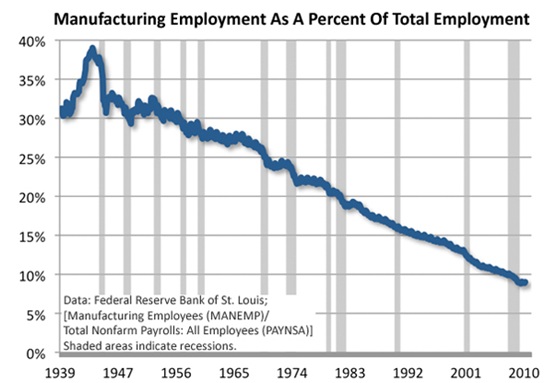

| A New Generation of Manufacturing: The Market Based Manufacturing Incentives Act |
 |
 |
 |
|
For over a generation, this nation has seen an unmistakable deterioration in our manufacturing sector, as is evident in the graph below. Not only does this compromise the financial security that comes with reliable, middle-class jobs for millions of Americans, but it threatens our economic standing as a global leader. This may cause some to say that American manufacturing is dying out, that this trend is merely part of our transition to a service-based economy, but I say those people are wrong.
In reality, the American manufacturing sector isn’t failing – it’s evolving. In my Silicon Valley district, manufacturing still plays a leading role on our local economy. Among our nation’s largest metropolitan areas, we have one of the highest percentages of the workforce involved in the manufacturing sector at nearly 20% -- more than twice the national average. While the factory floors no longer look like your grandfather’s workroom, by using the business model of Silicon Valley companies, we can recapture many of the jobs we’ve lost, become a country that makes products again, and remain globally competitive in the 21st century. Starting with businesses like the Ford Motor Company in the Rust Belt, manufacturers have played a leading role in propelling our nation to economic greatness, growing the middle class, and turning America into a land of opportunity. I believe domestic manufacturers can – and will – reassume this role in the decades ahead, but not without innovative policy ideas that reverse our current national trend. First and foremost, we must address the root cause of the decline of American manufacturing, start providing incentives to level the playing field with our global competitors, and change the math so that it makes economic sense for companies to manufacture in the United States. My Market Based Manufacturing Incentives Act (H.R. 3495) recognizes the new future of manufacturing and would build on our nation’s inherent advantages to “insource” much-needed American jobs.
How the Market Based Manufacturing Incentives Act Works The Market Based Manufacturing Incentives Act creates a nonpartisan commission of experts from the private sector that will identify the next ten game-changing technologies (technologies that create new markets and displace earlier technologies) and give consumers of these products a tax credit as long as they are manufactured in the United States. The commission will also recommend the size (between 5 and 20 percent) and the duration (from 5 to 10 years) of a consumer tax credit for each product. Unlike other proposals that directly subsidize businesses, this proposal relies on one of the most important inherent advantages of the United States, our consumer market. We may not be able to match dollar-for-dollar the government support that businesses receive in other nations, but our consumer market is an unparalleled dynamic of international commerce: Every business around the globe is clamoring for access to American consumers. This proposal would make it cheaper for consumers in the world’s largest economy to buy products that are domestically made. Because of this consumer credit, when a domestically made product is competing side-by-side with a foreign-made item, U.S. - made products will have more competitive on the shelf prices, regardless of any disadvantages they may have faced on labor, regulatory, and production costs. Just because we believe in a living wage, clean air and water, and safe workplaces doesn’t mean we can’t compete – and win. This bill shows us how.
|
![]()
Bill Name (i.e. HR 1776)
Or search by Keyword
My Legislative
Record In The
112th Congress
Sponsored bills
Co-sponsored bills
Floor Speeches
Legislative Links
Recent votes
House Calendar
House Floor Proceedings
The Daily Whip
Active Legislation
My Work in Congress FAQ
View our Privacy Policy.
Comments? Suggestions? Tell me how I can make this website more useful to you.
Please note that display of commercial logos does not indicate official endorsement of any product or website.


